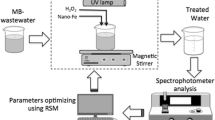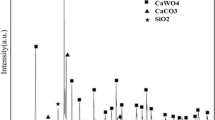Abstract
The optimum conditions for acid activation of diatomite for maximizing bleaching efficiency of the diatomite in sun flower oil treatment were studied. Box–Behnken experimental design combining with response surface modeling (RSM) and quadratic programming (QP) was employed to obtain the optimum conditions of three independent variables (acid concentration, activation time and solid to liquid) for acid activation of diatomite. The significance of independent variables and their interactions were tested by means of the analysis of variance (ANOVA) with 95 % confidence limits (α = 0.05). The optimum values of the selected variables were obtained by solving the quadratic regression model, as well as by analyzing the response surface contour plots. The experimental conditions at this global point were determined to be acid concentration = 8.963 N, activation time = 11.9878 h, and solid to liquid ratio = 221.2113 g/l, the corresponding bleaching efficiency was found to be about 99 %.


Similar content being viewed by others
References
Adinarayana K, Ellaiah P (2002) Response surface optimization of the critical medium components for the production of alkaline protease by a newly isolated Bacillus sp. J Pharma Pharm Sci 5:272–278
American Oil Chemists’ Society (1997) Color wesson method using color glasses calibrated in accordance with the AOCS tintometer color scale, official methods and recommended practices of the American Oil Chemists’ Society. AOCS Press, Champaign, Method Cc 13b-45
Boki KH, Kawasaki N (1994) Bleaching rapeseed and soybean oils with synthetic adsorbents and attapulgites. J Am Oil Chem’ Soc 71:505–601
Breen C, Zahoor ED, Madejovä J, Komadel P (1997) Characterization and catalytic activity of acid-treated size-fractionated smectites. The J Phys Chem B 101:5324–5331
Christidis GE, Kosiari S (2003) Decolorization of vegetable oils: a study of the mechanism of adsorption of b-carotene by an acidactivated bentonite from Cyprus. Clays Clay Miner 51(3):327–333
Christidis GE, Scott PW, Dunham AC (1997) Acid activation and bleaching capacity of bentonites from the Islands of Milos and Chios, Aegean, Greece. Appl Clay Sci 12:329–347
Didi MA, Makhoukhi B, Azzouz A, Villemin D (2008) Colza oil bleaching through optimized acid activation of bentonite. A comparative study. Appl Clay Sci 42:336–344
Falaras P, Kovanis I, Lezo F, Seiragakis G (1999) Cottonseed oil bleaching by acid-activated montmorillonite. Clay Miner 34:221–232
Kheok SC, Lim E (1982) Mechanism of palm oil bleaching by montmorillonite clay activated at various acid concentrations. J Am Oil Chem Soc 59:129–131
Liu HL, Lan YW, Cheng YC (2004) Optimal production of sulphuric acid by Thiobacillus thiooxidans using response surface methodology. Process Biochem 39:1953–1961
Morgan DA, Shaw DB, Sidebottom TC, Soon TC, Taylor RS (1985) The function of bleaching earths in the processing of palm kernel and coconut oils. J Am Oil Chem Soc 62:292–299
Mounts TL (1981) Chemical and physical effects of processing fats and oils. J Am Oil Chem Soc 58:51A–54A
Oboh AO, Aworh OC (1988) Laboratory trials on bleaching palm oil with selected acid-activated Nigerian clays. Food Chem 27:311–317
Önal M, Sarıkaya Y, Alemdaroğlu T, Bozdoğan I (2002) The effect of acid activation on some of the physicochemical properties of a bentonite. Turk J Chem 26:409–416
Rossi M, Gianazza M, Alamprese C, Stanga F (2003) The role of bleaching clays and synthetic silica in palm oil physical refining. Food Chem 82:291–296
Rupert JP, Granquist WT, Pinnavaia TJ (1987) Catalytic properties of clay minerals. In: Newman ACD (ed) Chemistry of clays and clay minerals. Mineralogical Society, London
Sen R, Swaminathan T (2004) Response surface modeling and optimization to elucidate and analyze the effects of inoculum age and size on surfactin production. Biochem Eng J 21:141–148
Srasra E, Bergaya F, Van Damme H, Ariguib NK (1989) Surface properties of an activated bentonite-decolourization of rape-seed oil. Appl Clay Sci 4:411–421
Temuujin J, Senna M, Jadamba T, Burmaa D, Erdenechimeg S, MacKenzie KJD (2006) Characterization and bleaching properties of acid-leached montmorillonite. J Chem Technol Biotechnol 81:688–693
Vicente-Rodriquez MA, Suarez M, Lopez-Ganzlez JD, Bänares-Munoz MA (1996) Characterization, surface area and porosity analyses of the solids obtained by acid leaching of a saponite. Langmuir 12:566–572
Zschau W (2001) Bleaching of edible fats and oils. Eur J Lipid Sci Technol 103:505–551
Author information
Authors and Affiliations
Corresponding author
Rights and permissions
About this article
Cite this article
Larouci, M., Safa, M., Meddah, B. et al. Response surface modeling of acid activation of raw diatomite using in sunflower oil bleaching by: Box–Behnken experimental design. J Food Sci Technol 52, 1677–1683 (2015). https://doi.org/10.1007/s13197-013-1113-9
Revised:
Accepted:
Published:
Issue Date:
DOI: https://doi.org/10.1007/s13197-013-1113-9




